Submarine Optical Fiber Cable Market Size
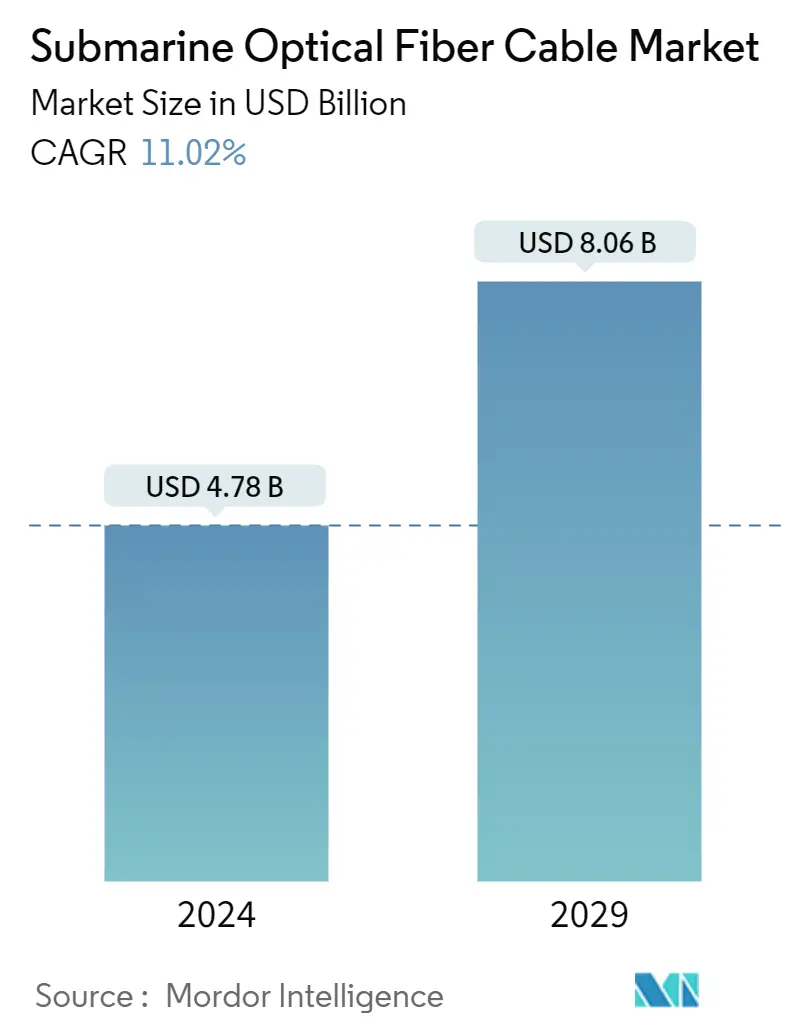
| Study Period | 2019 - 2029 |
| Base Year For Estimation | 2023 |
| Market Size (2024) | USD 4.78 Billion |
| Market Size (2029) | USD 8.06 Billion |
| CAGR (2024 - 2029) | 11.02 % |
| Market Concentration | Low |
Major Players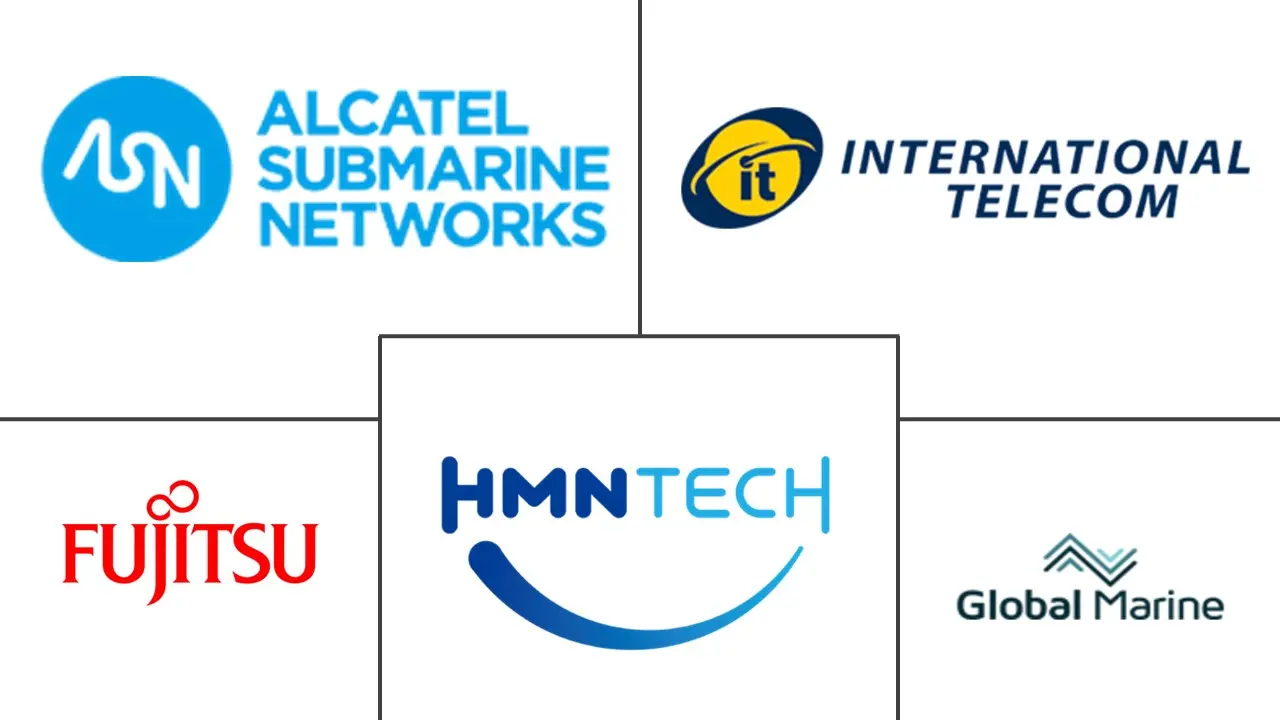
*Disclaimer: Major Players sorted in no particular order |
Submarine Optical Fiber Cable Market Analysis
The Submarine Optical Fiber Cable Market size is estimated at USD 4.78 billion in 2024, and is expected to reach USD 8.06 billion by 2029, growing at a CAGR of 11.02% during the forecast period (2024-2029).
Growing investment in high-speed internet infrastructure is one of the major factors driving the growth of the submarine optical fiber cable market. The continuous increase in the generation and transfer of vast amounts of data worldwide is one of the primary drivers of the market. Hence, many internet backbone operators will invest in the submarine optical fiber cable market during the forecast period.
- Global offshore wind power growth is expected to fuel market growth. The Global Wind Energy Council (GWEC) has stated that the United States is among the largest offshore wind markets. However, countries like the United Kingdom, Germany, China, Japan, and Taiwan are investing significantly in developing their offshore wind energy industry, creating a favorable scenario for market growth.
- With the rapid growth of data usage worldwide, there is an increasing demand for low-latency, high-capacity communications infrastructure. Submarine under Sea Optical fiber cables have emerged as a preferred solution to address the need for high-capacity, low-latency communication infrastructure.
- Fiber optics provide a more dependable, faster, and higher bandwidth mode of data transfer than traditional lines used by most utilities. Submarine Fiber optic networks send data by pulsing light via glass fiber strands approximately the size of human hair. When digital signals are sent via light, there is no external interference and reduced signal loss. This results in a more dependable data transmission network across vast distances. Furthermore, as these networks expand, user traffic continues to rise, necessitating the creation of standardized fiber testing procedures.
- The higher maintenance cost associated with the submarine optical fiber cable is analyzed to restrain the submarine optical fiber cable market growth, as the laying and maintenance of submarine fiber optical cables require a massive amount of human and material resources, including ships, divers, laying equipment, etc. This translates to a high cost of laying, repairing, and maintaining submarine optical fiber cables.
- The expansion of the world economy directly impacts the need for submerged optical connections. Expanding economies necessitate increasingly extensive undersea cable networks due to the need for high-speed internet connectivity. For instance, according to the World Bank estimate, the North American GDP, which was USD 32.32 trillion in 2023, is predicted to increase by 1.5% in 2023-24, suggesting that corporate activity and possible submarine optical fiber cable investments are projected to flourish.
Submarine Optical Fiber Cable Market Trends
Growing Smartphone Penetration and Increasing Demand for Internet Bandwidth to Drive the Market
- The smartphone industry has witnessed significant growth in recent years. The growing acceptance and prevalence of digital technologies, the advent of 5G, and the mobile-first approach of businesses are among the major factors driving the adoption of smartphones. According to Ericsson, the global number of smartphone subscribers is expected to reach 7.743 billion in 2028 from 6.421 billion in 2022.
- Furthermore, according to Ericsson, Northeast Asia was the leading region in terms of the number of smartphone subscribers (1.990 billion in 2022), followed by China (1.570 billion) and Southeast Asia and Oceania (910 million). All these factors positively contribute to the growth of the market studied, as a higher smartphone subscription positively impacts internet consumption and the amount of data being generated, which, in turn, drives the demand for data centers and other digital infrastructures wherein high bandwidth connectivity is a crucial requirement.
- According to the Ericsson Mobility report released in November 2023, a continued strong surge in global average data consumption per smartphone is expected to increase from 21GB/month in 2023 to 56GB/month by 2029. Such developments have positively influenced the increased demand for internet bandwidth and, in turn, driven the demand for submarine optical fiber cable.
- Increased bandwidth, ultra-low latency, and faster connectivity are expanding civilizations, revolutionizing industries, and radically improving day-to-day experiences. Bandwidth demands typically grow significantly every year. Hence, there is a constant trend toward higher bandwidth services and driving the growth of the submarine optical fiber cable market.
- For instance, in January 2024, Indian Prime Minister Narendra Modi, in Kavaratti, Lakshadweep, inaugurated the Kochi-Lakshadweep islands submarine optical fiber connection (KLI-SOFC) project among various developmental projects worth more than INR 1,150 crore (USD 13.88 million) covering a wide range of sectors, including water resources, healthcare, technology, energy, and education.
- The KLI-SOFC project will boost internet speed, unlocking new possibilities and opportunities. The dedicated submarine OFC will ensure a paradigm shift in communication infrastructure in the Lakshadweep islands, enabling more and faster reliable internet services, educational initiatives, digital banking, telemedicine, e-governance, digital currency usage, digital literacy, etc.
- Such developments, coupled with growing smartphone penetration and a growing need for reliable, low-latency, and high-speed communication infrastructure worldwide, are expected to drive the growth of the market studied during the forecast period.
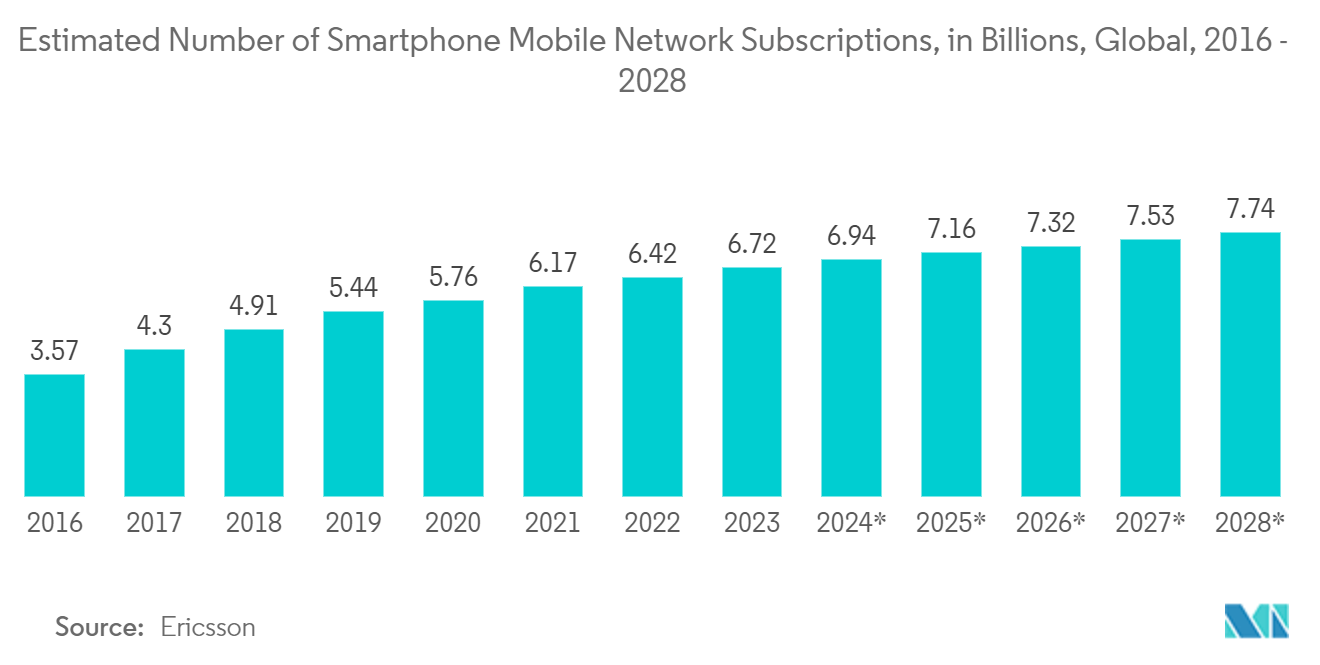
Trans-Pacific Region is Expected to Hold Significant Market Share
- Submarine cables carry over 97% of all internet traffic worldwide, and nearly everyone uses the Internet for daily tasks. Due to the Internet's ability to connect people worldwide, international traffic is growing daily. Asia-Pacific accounts for about half of all internet traffic worldwide, which in turn is increasing demand for submarine communication cables. The lack of submarine communication cable systems in the countries in this region is to blame for the need for faster internet services in the Transpacific region, which has prompted the World Bank and the Asia Development Bank to fund new cable systems.
- According to the Ministry of Internal Affairs and Communications (Japan), in 2023, the number of fiber-to-the-home (FTTH) subscriptions in Japan reached more than 38 million. In 1999, FTTH was introduced to the Japanese market, providing high bandwidth and high-speed internet access at a comparatively low price.
- As of October 2023, according to a joint US-Australian agreement, Alphabet (Google) operated underwater cables that provided internet connectivity to at least eight isolated Pacific Ocean countries. The project aims to expand Google's existing business activities in the region. Micronesia, Kiribati, the Marshall Islands, Papua New Guinea, the Solomon Islands, Timor-Leste, Tuvalu, and Vanuatu are all included in the project.
- In January 2023, Infinera announced that Infinera's ICE6 800G coherent optical solution had been deployed to modernize and increase capacity on the trans-Pacific Unity submarine cable system. By upgrading to Infinera's ICE6 solution, the Unity cable system will double capacity and deliver up to 7.4 Tbps per fiber pair. The Unity cable system was ready for service in April 2010, jointly built by a consortium comprising Bharti Airtel Limited, Global Transit Limited (a wholly-owned subsidiary of TIME), Google, KDDI Corp., Telstra, and Singtel.
- Moreover, according to Corporate IT, the Fondo de Infraestructura SA of Chile has selected H2 Cable LP, a subsidiary of BW Digital, as a strategic partner for developing the Humboldt Cable System, the first submarine cable connecting Latin America with Asia-Pacific and Oceania. With a projected extension of 14,810 km, the Humboldt Cable System will provide end-to-end connectivity.
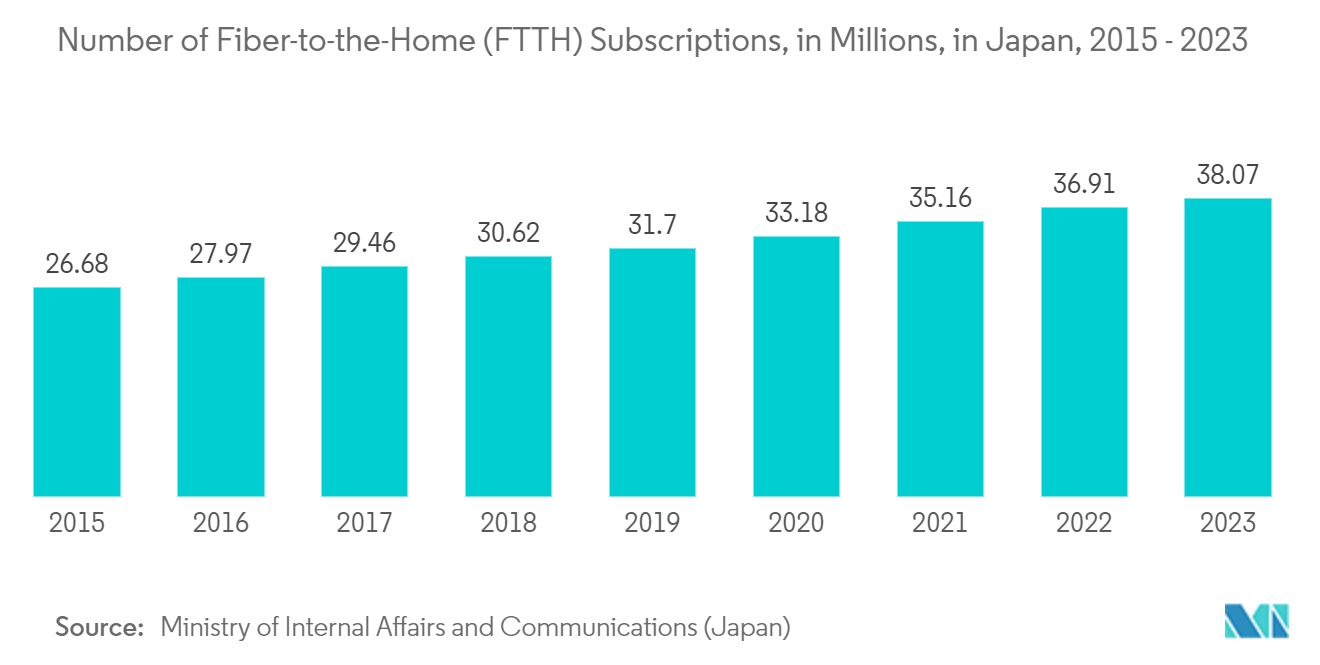
Submarine Optical Fiber Cable Industry Overview
The submarine optical fiber cable market is fragmented, with the presence of significant players like Alcatel Submarine Networks Ltd, Fujitsu Ltd, Global Marine Group, HMN Technologies Co., Ltd, and IT International Telecom Inc. Vendors in the market are adopting strategies such as partnerships, mergers, innovations, and acquisitions to enhance their product offerings and gain sustainable competitive advantage.
In September 2023, Orange announced expanding its submarine cable industry's investment to remain at the forefront of cable laying and maintenance technologies. Building a new cable ship represents a more significant investment than converting an existing vessel. Still, it means that Orange benefits from a ship with a minimal environmental footprint that is fully equipped to meet growing global connectivity needs. The Sophie Germain is 100 meters long and includes A hull designed and tested in a model tank to reduce fuel consumption optimized for cable repairs. A state-of-the-art 450 kW ROV (Remotely Operated Vehicle) is used to cut, inspect, and bury cables stored on board in a dedicated hangar.
Orange Marine designed and built the ROV in-house. Being connected to an onshore power supply will enable it to reduce its carbon emissions when docked. "CLEANSHIP" classification (controlled detection of refrigerant gas leaks, special anti-fouling coating, large waste storage capacity, etc.) A small environmental footprint, allowing a 20% reduction in CO2 emissions and an 82% reduction in nitrogen oxide emissions. Moreover, Orange Marine has defined all these characteristics based on its extensive experience in submarine cable operations.
In September 2023, NEC Corporation completed a long-distance field trial of an optical submarine cable system using a new transponder that, according to NEC, has the world's highest level of transmission performance of 800 gigabits per second (Gbps). This record-breaking field trial was conducted using the Indonesia Global Gateway (IGG) optical submarine cable(*) owned by PT Telkom Indonesia (Persero) Tbk (Telkom), Indonesia's largest telecommunications carrier, and using NEC's latest transponder, the XF3200. In the field trial, NEC conducted wavelength division optical transmission of 800 Gbps optical signals over 2,100 km, the longest recorded.
Submarine Optical Fiber Cable Market Leaders
-
Alcatel Submarine Networks Ltd
-
Fujitsu Ltd
-
Global Marine Group
-
HMN Technologies Co., Ltd.
-
IT International Telecom Inc.
*Disclaimer: Major Players sorted in no particular order
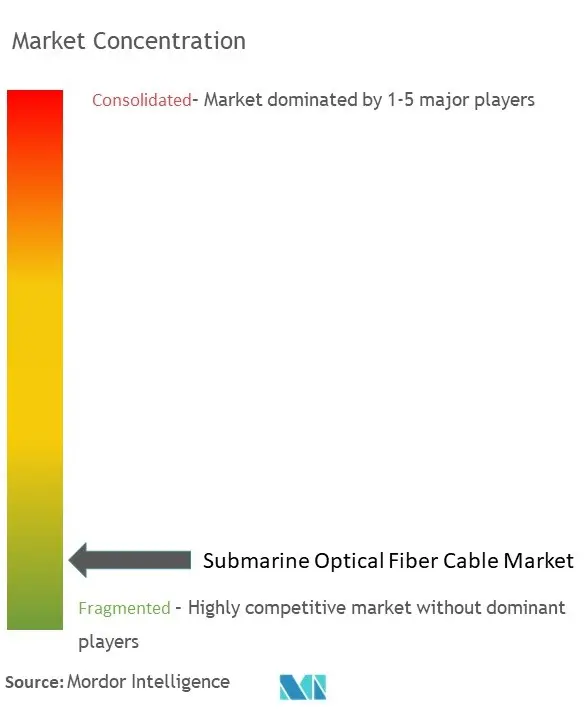
Submarine Optical Fiber Cable Market News
- October 2023 - NEC Corporation announced that the Patara-2 submarine cable system, owned by Telkom Indonesia, the digital telco in Indonesia, is now complete and operational. This system connects multiple islands across Indonesia. NEC Corporation highlighted that the Patara-2 is a 100 Gigabit per second (Gbps) x 80 wavelengths (wl) x 2 fiber pairs (fp) optical fiber submarine cable system measuring approximately 1,200 kilometers. In addition to the existing Sulawesi Maluku Papua Cable System (SMPCS) and others provided by NEC in India, this new cable system is said to enhance connectivity among the cities of Waisai, Manokwari, and Supiori.
- September 2023 - Nexans added a third cable layer to its fleet. Like its flagship vessel, Nexans Aurora, it will be built by Ulstein Verft in Ulsteinvik, Norway, using a design developed by Alesund, Norway, based on Skipsteknisk (ST). According to the Nexans, the third-generation cable layer aims to be equipped with three turntables, offering a 13,500-tonne loading capacity. It aims to host an extensive range of subsea tooling, including jetting and plowing tools. Set for delivery in 2026, the vessel will be capable of laying up to four cables simultaneously to meet specific customer requirements, especially on large-scale projects. Moreover, according to the Nexans, this new vessel will be the most technologically advanced cable layer ever deployed. Fitted with a range of high-tech cable installation and burial equipment, it will enhance the capabilities of our subsea cable operations to tackle projects on an unprecedented scale.
Submarine Optical Fiber Cable Market Report - Table of Contents
1. INTRODUCTION
- 1.1 Study Assumptions and Market Definition
- 1.2 Scope of the Study
2. RESEARCH METHODOLOGY
3. EXECUTIVE SUMMARY
4. MARKET INSIGHTS
- 4.1 Market Overview
-
4.2 Industry Attractiveness - Porter's Five Forces Analysis
- 4.2.1 Bargaining Power of Suppliers
- 4.2.2 Bargaining Power of Buyers
- 4.2.3 Threat of New Entrants
- 4.2.4 Threat of Substitute Products
- 4.2.5 Degree of Competition
- 4.3 Industry Value Chain Analysis
- 4.4 Impact of Macro Trends on the Industry (Include Impact of COVID-19)
- 4.5 List of Companies (Owners, Manufacturers, and Installers)
- 4.6 List of Submarine Optical Fiber Cable Name
5. MARKET DYNAMICS
-
5.1 Market Drivers
- 5.1.1 Growing Smartphone Penetration and Increasing Demand for Internet Bandwidth
- 5.1.2 Increasing Fiber Connectivity in Emerging Regions
-
5.2 Market Challenges
- 5.2.1 Higher Maintenance Costs and Growing Investment in Satellite Communication
6. MARKET SEGMENTATION
-
6.1 By Geography
- 6.1.1 Trans-Pacific
- 6.1.2 Trans-Atlantic
- 6.1.3 United States-Latin America
- 6.1.4 Intra-Asia
- 6.1.5 Europe-Asia
- 6.1.6 Europe-Sub Saharan Africa
7. COMPETITIVE LANDSCAPE
-
7.1 Company Profiles*
- 7.1.1 Alcatel Submarine Networks Ltd
- 7.1.2 Fujitsu Ltd
- 7.1.3 Global Marine Group
- 7.1.4 HMN Technologies Co., Ltd.
- 7.1.5 IT International Telecom Inc.
- 7.1.6 LS Cable & System Ltd
- 7.1.7 PT Communication Cable System Indonesia TBK
- 7.1.8 LS Cable & System Ltd
- 7.1.9 NEC Corporation
- 7.1.10 Nexans SA
- 7.1.11 NTT Communications Corporation
- 7.1.12 Orange Marine
- 7.1.13 Prysmian SPA
- 7.1.14 Pt Communication Cable System Indonesia TBK
- 7.1.15 S.B. Submarine Systems Co. Ltd (SBBS)
- 7.1.16 Subcom LLC
- 7.1.17 Sumitomo Electric Industries Ltd
- 7.1.18 Google LLC (Alphabet Inc.)
8. INVESTMENT ANALYSIS
9. MARKET OPPORTUNITIES AND FUTURE TRENDS
** Subject To AvailablitySubmarine Optical Fiber Cable Industry Segmentation
A submarine optical fiber cable is laid beneath the sea on the seabed. These cables carry telegraphy traffic at the initial stages of application. However, with technological advancements, the next generation of these cables carry telephone and data communication traffic. Currently, cables use optical fiber technology to carry digital data, viz., the internet, private data traffic, and telephones.
The submarine optical fiber cable market is segmented by geography (Trans-Pacific, Trans-Atlantic, United States-Latin America, Intra Asia, Europe-Asia, and Europe-Sub-Saharan Africa). The market sizes and forecasts regarding value in (USD) for all the above segments are provided.
| By Geography | Trans-Pacific |
| Trans-Atlantic | |
| United States-Latin America | |
| Intra-Asia | |
| Europe-Asia | |
| Europe-Sub Saharan Africa |
Submarine Optical Fiber Cable Market Research FAQs
How big is the Submarine Optical Fiber Cable Market?
The Submarine Optical Fiber Cable Market size is expected to reach USD 4.78 billion in 2024 and grow at a CAGR of 11.02% to reach USD 8.06 billion by 2029.
What is the current Submarine Optical Fiber Cable Market size?
In 2024, the Submarine Optical Fiber Cable Market size is expected to reach USD 4.78 billion.
Who are the key players in Submarine Optical Fiber Cable Market?
Alcatel Submarine Networks Ltd, Fujitsu Ltd, Global Marine Group, HMN Technologies Co., Ltd. and IT International Telecom Inc. are the major companies operating in the Submarine Optical Fiber Cable Market.
What years does this Submarine Optical Fiber Cable Market cover, and what was the market size in 2023?
In 2023, the Submarine Optical Fiber Cable Market size was estimated at USD 4.25 billion. The report covers the Submarine Optical Fiber Cable Market historical market size for years: 2019, 2020, 2021, 2022 and 2023. The report also forecasts the Submarine Optical Fiber Cable Market size for years: 2024, 2025, 2026, 2027, 2028 and 2029.
Submarine Optical Fiber Cable Industry Report
Statistics for the 2024 Submarine Optical Fiber Cable market share, size and revenue growth rate, created by Mordor Intelligence™ Industry Reports. Submarine Optical Fiber Cable analysis includes a market forecast outlook for 2024 to 2029 and historical overview. Get a sample of this industry analysis as a free report PDF download.



